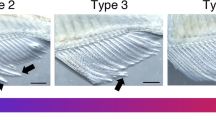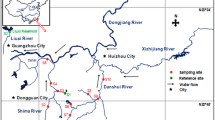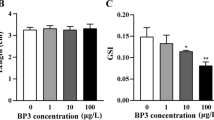Abstract
Three days post-parturition mosquitofish were exposed to different concentrations of 4-NP following a semi-static protocol. Exposure lasted up to the development of male anal fin in male individuals of the control group. Exposure to 50 μg/L 4-NP resulted in 100% females considering secondary sexual characters, while external sex-ratio did not statistically differed from unity in control group. In group exposed to 0.5 and 5.0 μg/L sex-ratio did not differ from unity but incompletely developed gonopodium was observed in several individuals. Individuals exposed to 50 μg/L 4-NP exhibited female or undeveloped gonads, while gonadal sex-ratio did not statistically differ from unity in control group. Percentage of undeveloped gonads increased with 4-NP concentration. Additional observations demonstrated hepatic histopathology in fish exposed to the highest concentration and growth reduction dependent on 4-NP concentration. In a complementary experiment, extensive metabolism of [3H]4-n-NP was characterized following in vivo exposure of juvenile mosquitofish suggesting that metabolism could modulate 4-NP toxicity. This study suggests susceptibility of early life stages of mosquitofish to endocrine modulators with regard to development of reproductive capabilities.
Similar content being viewed by others
References
Arcand-Hoy, L.D. and Benson, W.H. (1998). Fish reproduction: an ecologically relevant indicator of endocrine disruption. Environ. Toxicol. Chem. 17, 49-57.
Arukwe, A., Knudsen, F.R. and Goksøyr, A. (1997). Fish zona radiata eggshell protein: a sensitive biomarker for environmental estrogens. Environ. Health Perspect. 105, 418-22.
Arukwe, A. and Goksøyr, A. (1998). Xenobiotics, xenoestrogens, and reproduction disturbances in fish. Sarsia 83, 225-41.
Baroiller. J.-F., Guiguen, Y. and Fostier A. (1999). Endocrine and environmental aspects of sex differentiation in fish. Cell. Mol. Life Sci. 55, 910-31.
Biagianti-Risbourg, S. (1997). Les perturbations ultra structurales du foie des poissons utilisees comme biomarqueurs de la qualité sanitaire des milieux aquatiques. In L. Lagadic, J.C. Amiard, T. Caquet and F. Ramade eds Utilisation de Biomarqueurs en Ecotoxicologie, Collection Sciences de l'Environnement, pp. 355-391. Paris: Masson.
Bortone, S.A. and Davis, W.P. (1994). Fish intersexuality as indicator of environmental stress. Bioscience 44, 165-72.
Bragadin, M., Perin, G., Iero, A., Manente, S., Rizzoli, V. and Scutari, G. (1999). An in vitro study on the toxic effects of nonylphenols NP in mitochondria. Chemosphere 38, 1997-2001.
Braunbeck, T. (1995). Detection of environmentally relevant concentrations of toxic organic compounds using histological and cytological parameters: substance-specificity in the reaction of rainbow trout liver? Proceedings of EIFAC Symposium on Sublethal and Chronic Effects of Pollutants on Freshwater Fish, Lugano, May 1992.
Christiansen, T., Korsgaard, B. and Jespersen, A. (1998). Effects of nonylphenol and 17β-estradiol on vitellogenin synthesis, testicular structure and cytology in male eelpout Zoarces viviparus. J. Exp. Biol. 201, 179-92.
Danzo, B.J. (1998). The effects of environmental hormones on reproduction. Cell. Mol. Life Sci. 54, 1249-64.
Duan, C. (1997). The insulin-like growth factor system and its biological actions in fish. Amer. Zool. 37, 491-503.
Gimeno, S., Komen, H., Venderbosch, P.W.M. and Bowmer, T. (1997). Disruption of sexual differentiation in genetic male common carp Cyprinus carpio exposed to an alkylphenol during different life stages. Environ. Sci. Technol. 31, 2884-90.
Gimeno, S., Komen, H., Gerritsen, A.G.M. and Bowmer, T. (1998). Feminisation of young male of the common carp, Cyprinus carpio, exposed to 4-tert-pentylphenol during sexual differentiation. Aquatic Toxicol. 43, 77-92.
Goetz, F.W., Donaldson, E.M., Hunter, G.A. and Dye, H.M. (1979). Effects of estradiol-17β and 17 β-methyltestosterone on gonadal differentiation in the coho salmon, Oncorhynchus kisutch. Aquacult. 17, 267-78.
Gray, M.A. and Metcalfe, C.D. (1997). Induction of testis-ova in japanese medaka Oryzias latipes exposed to p-nonylphenol. Environ. Toxicol. Chem. 16, 1082-6.
Hinton, D.E. and Lauren D.J. (1990). Liver structural alterations accompanying chronic toxicity in fishes: potential biomarkers of exposure. In J.F. McCarthy and L.R. Shugart eds Biomarkers of Environmental Contamination, pp. 17-57. Boca Raton, FL: Lewis Pubs.
Hunter, G.A., Solar, I.I., Baker, I.J. and Donaldson, E.M. (1986). Feminization of coho salmon Oncorhynchus kisutch and chinook salmon Oncorhynchus tshawytscha by immersion of alevins in a solution of estradiol-17β. Aquacult. 53, 295-302.
Johnstone, R., Simpson, T.H. and Youngson, A.F. (1978). Sex reversal in salmonid culture. Aquacult. 13, 115-34.
Koya, Y., Itazu, T. and Inoue, M. (1998). Annual reproductive cycle based on histological changes in the ovary of the female mosquitofish, Gambusia affinis, in central Japan. Ichtyol. Res. 45, 241-8.
Krisfalusi, M., Eroschenko, V.P. and Cloud, J.G. (1998). Exposure of juveniles rainbow trout Oncorhynchus mykiss to methoxychlor results in a dose-dependent decrease in growth and survival but does not alter male sexual differentiation. Bull. Environ. Contam. Toxicol. 60, 659-66.
Lech, J.J., Lewis, S.K. and Ren L. (1996). In vivo estrogenic activity of nonylphenol in rainbow trout. Fund. Appl. Toxicol. 30, 229-32.
Le Gac, F., Blaise, O., Fostier, A., Le Bail, P.-Y., Loir, M., Mourot, B. and Weil, C. (1993). Growth hormone GH and reproduction: a review. Fish Physiol. Biochem. 11, 219-32.
Neubert, D. (1997). Vulnerability of the endocrine system to xenobiotic influence. Regul. Toxicol. Pharmacol. 26, 9-29.
Nimrod, A.C. and Benson, W.H. (1996). Environmental estrogenic effects of alkylphenol ethoxylates. Crit. Rev. Toxicol. 26, 335-64.
Petit. F., Le Goff, P., Cravedi, J.-P., Valotaire, Y. and Pakdel, F. (1997). Two complementary bioassays for screening the estrogenic potency of xenobiotics: recombinant yeast for trout estrogen receptor and trout hepatocyte cultures. J. Mol. Endocrinol. 19, 321-35.
Stanton, M.F. (1965). Diethylnitrosamine-induced hepatic degeneration and neoplasia in the aquarium fish, Brachydanio rerio. J. Nat. Cancer Inst. 34, 117-30.
Tanghe, T., Devriese, G. and Verstraete, W. (1999). Nonylphenol and estrogenic activity in aquatic environmental samples, J. Environ. Qual. 28, 702-9.
Thibaut, R., Debrauwer, L., Rao, D. and Cravedi, J.-P. (1998).Characterisation of biliary metabolites of 4-n-nonylphenol in rainbow trout Oncorhynchus mykiss, Xenobiotica 28, 745-57.
Thibaut, R., Debrauwer, L., Rao, D. and Cravedi, J.P. (1999). Urinary metabolites of 4-n-nonylphenol in rainbow trout (Oncorhynchus mykiss). Sci. Total Envir. 233, 193-200.
Toguyeni, A., Baroiller, J.-F., Fostier, A., Le Bail, P.-Y., Rodriguez, J.-N., Mol, K., Kuhn, E.R. and Fauconneau, B. (1997). Etude du déterminisme physiologique du dimorphisme sexuel de croissance chez Oreochromis niloticus. In K. Fitzsimmons eds Proceedings of the Fourth International Symposium on Tilapia in Aquaculture, Orlando, Florida, NRAES-106, Vol. 2, pp. 739-59.
Tyler, C.R., Jobling, S. and Sumpter, J.P. (1998). Endocrine disruption in wildlife: a critical review of the evidence. Crit. Rev. Toxicol. 28, 319-61.
Zahnd, J.P. (1959). Modifications hepatiques liées au cycle ovarien chez deux espèces de poissons ovovivipares: Xiphophorus helleri et Lebistes reticulatus. Arch. Anat. Microsc. 48, 231-57.
Author information
Authors and Affiliations
Rights and permissions
About this article
Cite this article
Drèze, V., Monod, G., Cravedi, JP. et al. Effects of 4-Nonylphenol on Sex Differentiation and Puberty in Mosquitofish (Gambusia holbrooki). Ecotoxicology 9, 93–103 (2000). https://doi.org/10.1023/A:1008976431227
Issue Date:
DOI: https://doi.org/10.1023/A:1008976431227




